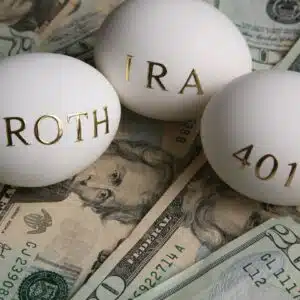Are you confused by all of the retirement plans that are available? There are quite a few, and there are even variations within each type of plan.
I’m going to help you select the best retirement plans, by providing a close look at each.
Maybe you’re about to start a plan, or you might even be considering taking two or more – which is hardly unusual.
We’ll provide you with the highlights of the various plans, as well as some of the drawbacks that you need to be aware of.
Individual Retirement Accounts (IRAs)
Table of Contents
The IRA is the most basic of all tax-sheltered retirement plans. Not only is it the easiest plan to set up and manage, but it’s also available to virtually anyone who has earned income. It also functions as something of a destination account, because virtually all other retirement plans can be rolled over into one, usually enabling the owner to escape immediate tax consequences as a result of the rollover.
Another selling point is that an IRA is completely self-directed. Unlike employer-sponsored plans, which typically limit your investments to a handful of mutual funds or exchange-traded funds (ETFs), an IRA can be held in a large investment brokerage account where it can be invested in nearly every asset class available.
That includes individual stocks, bonds, and other fixed-income instruments, funds, options, commodities, and real estate investment trusts (REITs). Most employer-sponsored plans don’t offer anything close to that many options.
There’s a very short list of prohibited IRA investments; otherwise, you can invest in anything else. Contributions must be made by the tax filing date following the calendar year (like April 15, 2024, for 2023).
There isn’t just one type of IRA either. IRAs come in three primary types:
Traditional IRA
This is the most common type of IRA. It allows you to contribute up to $7,000 per year ($8,000 if you’re 50 or older) into the plan and to deduct that contribution from your income tax (there are limits if you’re covered by an employer-sponsored retirement plan – see IRA Table below).
Your IRA grows on a tax-deferred basis, and will not become taxable until you begin taking distributions from the plan. If you are over age 59 1/2, those withdrawals will be taxed at ordinary income tax rates, which should be lower once you retire. If you make withdrawals before turning 59 1/2, they will be subject to not only ordinary income tax but also a 10% early withdrawal penalty.
How valuable is the tax deferral aspect of an IRA?
Let’s say that you invest $5,500 per year at 10%, and your combined federal and state income tax rate is 30%. That means that your after-tax return on your investment income is effectively 7%. In 20 years, your investment will grow to $233,367.
Now let’s say that you invest $5,500 per year at 10% in an IRA instead. Because of the tax deferral, your investing activities will not be subject to income tax; you will get the full benefit of the 10% return on investment. In 20 years your investment will grow to $330,763.
By saving and investing through an IRA account, you can earn and retain more than $97,000 more over 20 years, than you can by saving and investing through a taxable investment account!
Spousal IRA
If you are a non-working spouse, you may be eligible to qualify for a spousal IRA, even if you have no income. As long as your spouse is earning enough income to cover your IRA contribution, as well as his or her IRA, you can contribute to your own IRA.
For example, let’s say that your spouse earns $50,000 per year, and you have no income at all. Both you and your spouse can make a contribution into your own IRAs for $5,500 each year. Each IRA contribution would also be tax-deductible. That means that even though you have only one income between you, you would nonetheless be able to contribute a combined $11,000 to your respective IRAs. It’s an excellent strategy to accelerate your retirement savings.
You are only eligible for a spousal IRA if your tax status is married filing jointly. If you file separately, the spousal provision is not available. You would each maintain a separate IRA, in your own name. You can even put contributions into an existing IRA account – there’s no need to set up a brand-new account.
A spousal IRA is subject to all of the provisions and limitations of a traditional IRA. However, a non-working spouse can also set up a spousal Roth IRA, and it is also subject to all the provisions and limitations of a Roth IRA.
This brings us to the next type of IRA…
Roth IRA
A Roth IRA has most of the same advantages as a traditional IRA – tax-deferred investment income accumulation, unlimited investment options, and self-directed investing. But they have one major advantage over traditional IRAs, and it’s a game-changer:
Roth IRAs can provide tax-free income distributions in retirement! As long as you are at least 59 1/2, and have had a Roth for at least five years, there’s no tax on the distributions.
As I said, it’s a real game-changer. A Roth IRA can add tax diversification to your retirement portfolio. Most people assume that they will be in a lower tax bracket in retirement, but that’s not necessarily true. If you have multiple sources of income – Social Security, pension income, investment income, and withdrawals from other retirement plans – you may be in a higher income tax bracket than you think. Having a well-funded Roth IRA will provide you with a source of tax-free income, to cut down on that tax liability.
There are a few other important provisions and benefits that come with Roth IRAs:
- Unlike traditional IRAs, contributions to a Roth are not tax-deductible
- However, you can withdraw your contributions at any time, free from taxation or penalties (since there was no tax deduction taken on those contributions)
- Unlike virtually every other type of retirement plan, Roth IRAs do not require that you take required minimum distributions (see chart below)
That last point is an important one. RMDs require that you begin taking distributions from your retirement plan no later than age 73, based on your remaining life expectancy. That means that if you live another 20 years, you could drain those accounts down to nothing.
But you can keep your Roth IRA – literally for the rest of your life – so that you are never broke. And that means that you will always have at least some money to pass on to your heirs upon your death.
There’s another type of IRA too, the rollover IRA. But that’s basically either a traditional or Roth IRA, into which you roll over the funds from other retirement plans, including other IRAs. There are some provisions with these accounts, but they’re specific to the plan that’s been rolled over into one.
IRA TABLE
| PLAN | TRADITIONAL IRA | SPOUSAL IRA | ROTH IRA |
|---|---|---|---|
| 2024 Contribution Limits | $7,000, or $8,000 if age 50 or older | $7,000, or $8,000 if age 50 or older | $7,000, or $8,000 if age 50 or older |
| 2024 Annual Income Limits | If covered by an employer plan: Single, $77,000 to $87,000; MFJ, $123,000 to $143,000, Otherwise no limit | If spouse is covered by an employer plan, $230,000 to $240,000, Otherwise no limit | Single, $146,000 to $$161,000; MFJ, $230,000 to $240,000 |
| Tax Treatment During Accumulation | Contributions fully deductible, unless covered by an employer plan, then limits above apply; investment income tax deferred | Contributions fully deductible, unless covered by an employer plan, then limits above apply; investment income tax deferred | Contributions not deductible; investment income tax deferred |
| Tax Treatment Upon Withdrawal | Subject to ordinary income tax if taken after age 59.5; ordinary income tax plus 10% penalty if taken before | Subject to ordinary income tax if taken after age 59.5; ordinary income tax plus 10% penalty if taken before | Withdrawal of contributions not taxable; withdrawal of investment income not taxable after age 59.5 and at least 5 years in plan; investment income taxable on withdrawal – plus 10% penalty if taken prior to 59.5 |
| Investment Options | Unlimited | Unlimited | Unlimited |
| Required Minimum Distributions | Yes, each year beginning at age 73 | Yes, each year beginning at age 73 | Not Required |
| Miscellaneous | Can make non-tax deductible contributions even if income limits exceeded | Can make non-tax deductible contributions even if income limits exceeded | Even if you don’t qualify for a Roth contribution, you can make a “backdoor” Roth by making a contribution to a traditional IRA then doing a Roth conversion |
Traditional Pensions – Defined Benefit Contribution Plans
We’re not going to spend a lot of time on traditional pensions, mostly because relatively few workers are covered by them anymore, but also because the plans are completely controlled by your employer, with no input or action required on your part.
Traditional defined benefit contribution pension plans are mostly offered by government employers now. Most private-sector employers abandoned pension plans long ago in favor of defined contribution plans, like 401(k)s.
Basically, if your employer offers a traditional pension plan, your participation will be automatic. All of the details in connection with the plan – including the contribution amount, types of investments, terms of qualification, and monthly benefit – will be defined by the terms of the plan.
Typically, they will require you to be employed by the company for a certain minimum number of years (at least five) in order for you to be vested in the plan. Your benefit will be based on a formula that’s calculated based on your income, and years of service. The monthly benefit will be some percentage of your income. You will be able to retire at a certain predetermined age, such as 55, 59 1/2, 60, 62, or 65.
Throughout the term of your employment – and even if you terminate your employment before retirement – the pension plan will be controlled completely by your employer. This is one of the major reasons why employees often have other retirement plans, in addition to a traditional pension plan.
Employer-Sponsored Defined Contribution Plans – 401(k), 403(b), 457, TSP
Most employers today provide defined contribution plans that the employer sponsors. This includes 401(k), 403(b), 457, and Thrift Savings Plans (TSP). While these plans are now more common than traditional defined-benefit pension plans, they are often offered in conjunction with those traditional pensions.
There are four primary defined contribution plans:
401(k) Plans
The 401(k) is a popular defined contribution plan, mostly for private-sector employers. Much like IRAs, contributions are tax-deductible, and investment income accumulates on a tax-deferred basis. You can begin taking distributions from a plan as early as age 59 1/2, subject only to ordinary income tax (plus a 10% penalty if withdrawals are taken earlier). 401(k) plans also require RMDs beginning at age 73.
401(k) provides for much more generous contributions than IRAs. You can contribute up to $23,000 per year or $30,500 per year if you are 50 or older. What’s more, your employer can make a matching contribution, and many (but not all) employers offer this benefit.
Combined contributions from both employee and employer can reach up to $69,000, or $76,500 if you are 50 or older (both for 2024). When the employer offers a matching contribution, it is usually subject to vesting, which is a period of time in which the matching funds are not yet owned by you directly. It may take up to five years of employment in order for matching contributions to be fully vested.
While contributions are much more generous than they are for IRAs, investment options are usually much more limited. While a few employers may offer accounts through large, diversified investment brokers, such as Charles Schwab and Fidelity, most offer more limited investment options, such as a handful of mutual funds and perhaps employer company stock.
401(k) plans can often offer loan provisions, though this will depend upon whether or not your employer chooses to make them available. If they do, you can borrow up to 50% of the vested balance in the plan, up to a maximum of $50,000. Repayment terms are typically for five years or up to 15 years for real estate-related loans. Interest rates are generally more favorable than what you can get with a bank loan and are often set up as something like the prime rate +1%.
Some 401(k) plans may also make hardship withdrawals available for events such as medical costs or disability.
An increasing number of 401(k) plans also offer a Roth 401(k) portion. These work in much the same way as Roth IRAs, but they have the benefit of having higher contribution limits. You can contribute up to the maximum 401(k) contribution of $23,000 ($30,500 if you’re age 50 or older) between the Roth portion and the regular portion.
For example, if you make the maximum contribution of $23,000 per year to your 401(k), you can allocate $11,250 to the Roth portion and $11,250 to the regular portion of your 401(k).
The two accounts will be maintained separately, as the distributions from the Roth 401(k) will be tax-free, while the regular 401(k) distributions will be subject to ordinary income tax. Your employer can also make matching contributions to your Roth 401(k), except that the matching funds will be held in your regular 401(k), rather than your Roth 401(k).
You can make Roth 401(k) contributions even if your income exceeds the thresholds for a Roth IRA! This will eliminate the need to do a potentially costly Roth conversion.
403(b) Plans
403(b) plans are basically 401(k) plans for tax-exempt organizations such as hospitals, churches, and public schools. They work the same as 401(k) plans, including tax treatment, contribution amounts, distributions, loan and hardship withdrawal provisions, and employer matching contributions. They even offer a Roth 403(b) provision on the same terms as a Roth 401(k).
There is one significant area in which 403(b) plans work differently than 401(k) plans, and that’s that 403(b) plans have a special, additional catch-up provision. Employees who are employed for 15 years or more can contribute an extra $3,000 per year ($25,500 in total, or $33,000 if 50 or older) for five years ($15,000 total catch-up contributions) before turning 50, or in addition to the over-50 catch-up contribution.
457 Plans
457 plans are virtually identical with 401(k) and 403(b) plans, except that they are offered by state and local governments and some tax-exempt organizations.
Contribution amounts, tax treatment, distributions, loan and hardship withdrawal provisions and investment options are similar to the other employer plans. 457 plans also provide a Roth option under similar terms as the other plans.
Thrift Savings Plan (TSP)
The TSP works almost identically to the other employer-sponsored defined contribution plans. But the plan is available for federal employees, including members of the military.
It offers two major advantages over the other plans. The first is that federal employees are also covered by a defined benefit plan. That means that you can have two major retirement plans working in your favor throughout your government employment.
The second major advantage is that you will receive an employer-matching contribution of at least 1% of your income even if you don’t participate in the TSP. The total employer matching contribution can be as high as 5%, and is fully vested after just three years.
The major negative with the TSP, however, is that it offers very limited investment options. In fact, there are only five investment funds available. And while they are low-cost options, that cover the broad financial markets, you will not have the option to move into other investments if you are not pleased with the performance of the five funds, or if you want to get into alternative investments, such as individual stocks or real estate investment trusts.
EMPLOYER-SPONSORED DEFINED CONTRIBUTION PLANS TABLE
| PLAN | 401(K) | 403(B) | 457 | TSP |
|---|---|---|---|---|
| 2024 Contribution Limits | $23,000, or $30,500 of age 50 or older; Employer matching contributions to a maximum of $69,000 combined | $23,000, or $30,500 of age 50 or older; Employer matching contributions to a maximum of $69,000 combined | $23,000, or $30,500 of age 50 or older; Employer matching contributions to a maximum of $69,000 combined | $23,000, or $30,500 of age 50 or older; Employer matching contributions to a maximum of $69,000 combined |
| Contribution Source | Employee and employer | Employee and employer | Employee and employer | Employee, employer, or both |
| Tax Treatment During Accumulation | Contributions fully deductible, investment income tax deferred | Contributions fully deductible, investment income tax deferred | Contributions fully deductible, investment income tax deferred | Contributions fully deductible, investment income tax deferred |
| Tax Treatment Upon Withdrawal | Subject to ordinary income tax if taken after age 59.5; ordinary income tax plus 10% penalty if taken before | Subject to ordinary income tax if taken after age 59.5; ordinary income tax plus 10% penalty if taken before | Subject to ordinary income tax if taken after age 59.5; ordinary income tax plus 10% penalty if taken before | Subject to ordinary income tax if taken after age 59.5; ordinary income tax plus 10% penalty if taken before |
| Investment Options | Determined by employer | Determined by employer | Determined by employer | Determined by employer |
| Roth Provision | Yes | Yes | Yes | Yes |
| Loan Provision | Maximum 50% of vested balance, to a maximum of $50,000 – if permitted by employer | Maximum 50% of vested balance, to a maximum of $50,000 – if permitted by employer | Maximum 50% of vested balance, to a maximum of $50,000 – if permitted by employer | Maximum 50% of vested balance, to a maximum of $50,000 |
| Required Minimum Distributions | Yes, each year beginning at age 73 | Yes, each year beginning at age 73 | Yes, each year beginning at age 73 | Yes, each year beginning at age 73 |
| Miscellaneous | Special catch-up provision for public service workers with more than 15 years of service |
Self-Employed Retirement Plans – Solo 401(k), SEP IRA, Simple IRA
It’s quite possible that the self-employed have the best potential retirement plans available. There are at least three plans available, that provide contribution limits that often exceed employer-sponsored plans, but that also provide the flexibility and investment options that you can get from self-directed IRAs.
There are three basic retirement plans available to the self-employed:
Solo 401(k) Plan
Just as the name of the plan implies, a solo 401(k) is a 401(k) plan for the self-employed. It offers at least the same benefits as a 401(k) plan, with three major differences:
- It is a 401(k) plan for just an employer and the employer’s spouse – but not for employees
- The contribution limits are more generous than they are for an employer-sponsored plan (not technically, but that’s how it usually works out)
- As the sponsor of the plan, you are both the employer and employee
That last point is important because it’s the reason why your contribution limits will generally be higher than what they would be in an employer-sponsored plan. For example, with a solo 401(k), you can contribute up to $23,000 to the plan (or $30,500 if you’re 50 or older) as an employee. But you can also contribute up to 25% of your business net income to your plan as the employer.
That means that you can contribute up to $69,000 per year to your plan ($76,500 if you’re 50 or older) in total.
Let’s say that the net income from your business is $144,000. You can contribute $23,000 to your solo 401(k) as an employee. But you can also contribute 25% of your net income to the plan as the employer.
That works out to be $36,000, plus your $23,000 employee contribution, for a total of $58,500. That also works out to be a total contribution of 37.5% of your net income!
That’s not a bad haul from a single retirement program, and that’s what makes the solo 401(k) such a powerful plan.
And just as is the case with other retirement plans, there is also a Solo Roth 401(k) option available with the solo 401(k). It follows the same parameters as a Roth IRA.
SEP IRA
The full name of the plan is the Simplified Employee Pension Plan. As the name implies, it’s an IRA, but one set up by a small employer for him/herself and their employees, if any.
The SEP works the same way as a basic IRA, in regard to contributions, tax treatment, investment options, distributions, hardship withdrawals and RMDs.
But a SEP differs from a regular IRA in one very important respect – the size of your contribution. The difference is enormous.
With a regular IRA, your contribution is limited to $7,000 or $8,000 (50 or older). But a SEP IRA allows you to contribute up to 20% of your net business income, or as much as $69,000. (Technically speaking, you can contribute up to 25% of your income, but using the formula the IRS uses to calculate 25% effectively limits you to 20%, but it’s still a very generous contribution limit.)
Another benefit of the SEP IRA is that you can add employees to the plan as you hire them. However, each employee will have to open up an individual account for the plan. It is, after all, an IRA – with an emphasis on the “I” for the individual.
SIMPLE IRA
The SIMPLE IRA is also another variation of an IRA. It is for small businesses that employ fewer than 100 employees. Though it is technically an employer plan, the basic parameters are similar to a traditional IRA.
The contribution limits, however, are more generous than what they are for a traditional IRA. You can contribute 100% of your income to the plan, up to a maximum of $16,000 or $19,500 if you are 50 or older.
In order to qualify to make a contribution, you must earn a minimum of $5,000 in either of the past two years. It also has another major advantage over other small business retirement plans. A SIMPLE IRA does not require you to file a plan-specific tax return with the IRS.
There is one “catch” to the SIMPLE IRA. As an employer, you’ll have to make either a 3% matching contribution, or a 2% nonelective contribution (up to $5,000). In either case, the employer contribution percentage must be based on the employee’s compensation, which is your compensation if you’re self-employed.
Example
SELF-EMPLOYED RETIREMENT PLANS TABLE
| PLAN | SOLO 401(K) | SEP IRA | SIMPLE IRA |
|---|---|---|---|
| 2024 Contribution Limits | Up to $23,000 as employee ($30,500 of 50 or older), plus up to 25% of business net income to a maximum combined contribution of $69,000, or $76,500 if age 50 or older | Effectively, 20% of net income up to $69,000, or $76,500 if age 50 or older | Up to $16,000, or $19,500 if age 50 or older, plus an employer matching contribution of up to $3,500 |
| Tax Treatment During Accumulation | Contributions fully deductible, investment income tax deferred | Contributions fully deductible, investment income tax deferred | Contributions fully deductible, investment income tax deferred |
| Tax Treatment Upon Withdrawal | Subject to ordinary income tax if taken after age 59.5; ordinary income tax plus 10% penalty if taken before | Subject to ordinary income tax if taken after age 59.5; ordinary income tax plus 10% penalty if taken before | Subject to ordinary income tax if taken after age 59.5; ordinary income tax plus 10% penalty if taken before |
| Investment Options | Unlimited | Unlimited | Unlimited |
| Roth Provision | Yes | No | No |
| Loan Provision | Maximum 50% of vested balance, to a maximum of $50,000 | Not permitted | Not permitted |
| Required Minimum Distributions | Yes, each year beginning at age 73 | Yes, each year beginning at age 73 | Yes, each year beginning at age 73 |
| Miscellaneous | 3% employer matching contribution, or fixed contribution of 2% (up to $5,000 per employee) required; 25% penalty if distributions made within first two years of the plan |
As you can see, there are plenty of retirement plans available, so there’s no excuse not to save for your retirement. Whatever plan you choose, it’s important to get started. Retirement savings is all about the time value of money, so which plan you’re using may be less important than that you get it going as soon as possible. And once you do, save as much as you can, and invest it faithfully, even during those times when it doesn’t seem like the right thing to do.
Your future self will thank you when you reach retirement age!








I just share this blog post to my dad. This is really very informative article.
If a person is over 70 1/2 and is still working full time, can he contribute in any way to a tax defered plan offered by his company that employs him?
Hi James – You can continue to make contributions to your employer plan past 70.5 if you’re still employed. And as long as you don’t own 5% or more of the company, you’re also not required to begin taking required minimum distributions from the plan until you retire.
However RMDs are required from any IRAs you own, or previous employer plans. You are also not able to make contributions to a traditional IRA.
I hope this helps.
My husband and I are getting a little older, and we are looking to plan our retirement. I didn’t realize that a Roth IRA can add tax diversification to your retirement portfolio. We will have to find someone to help us with the paperwork involved in this process.
My husband and I are looking forward to planning our retirement. We want to make sure we have a financially stable plan. Thanks for this information on different retirement plans. I didn’t realize that IRAs are mainly self-directed. That’s good to know.
Hi Annika – That’s true about an IRA being self-directed. But so is a Roth IRA, and most self-employment plans, like SEP and SIMPLE IRAs and Solo 401(k)s. Some employer sponsored plans also offer self-directed investing too.
The number of retirement accounts is quite mind boggling. Good thing new investors have great resources such as yours, Jeff!
Jeff – I believe you comment about Roth 401(k) contribution limits is incorrect. You said that a Roth 401(k) has the same limits of a Roth IRA.
Hi Dan – You’re so right! Corrected! You can actually contribute up to the full 401k contribution to the Roth portion itself, as long as you don’t exceed the overall 401k contribution limit. Thanks for the catch.
Great tips. I think not knowing your fees is a huge obstacle. For that reason, we use index funds.
I love the analogy using the price of a car repair. Most things you know what your going to pay (or at least close). When it comes to retirement planning, its not as easy. And its not uncommon to be wildly off – and not even realize it as many fees are automatically deducted.